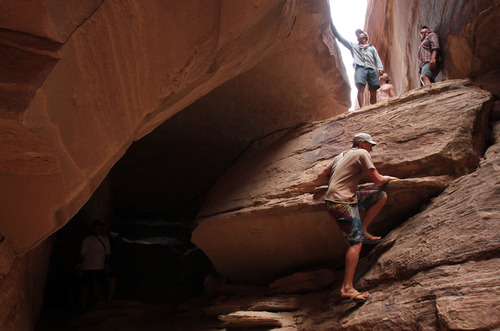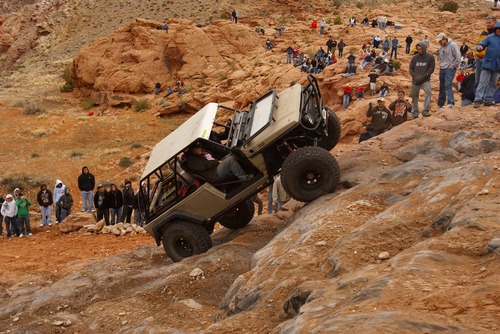This is an archived article that was published on sltrib.com in 2013, and information in the article may be outdated. It is provided only for personal research purposes and may not be reprinted.
For struggling college students whose only sustenance is ramen and Red Bull, going away for spring break is a luxury most can't always afford.
So when they do go, most look for the best deals and best value. And that's why savvy companies step up this time of year and why nearby Utah hotspots such as St. George and Moab have been popular destinations for quick, low-cost excursions.
In a 2011 Oklahoma State University study on what spring break travelers look for in a destination, geographic location, the total cost of the trip, and their general attitude about where they were going were the top three considerations in making a choice.
"Creating a favorable impression, with a reasonable price point, is the best marketing strategy to attract students for spring break," the study stated. "With almost half spending less than $500, the students are shopping for the best deal, while still having the desired spring break experience."
Student Scott Wiseman buys that notion.
He and 30 of his fraternity brothers headed to Las Vegas this past weekend for spring break through a deal on Expedia.com that included coupons for buffets and free tickets to a Cirque du Soliel show. With rooms at Mandalay Bay and driving costs, he said their entire trip — including gasoline — was around $100 per person.
"When we were shopping around, we wanted to go somewhere that was nice but that had a good value," said Wiseman, 21, a senior at the University of Utah.
With spring break this week at the U., many students are taking trips to Lake Havasu in Arizona, about 150 miles south of Las Vegas. The reason? Because a resort at the vacation getaway actively marketed to college students.
London Bridge Resort in Lake Havasu sends three employees on a tour of 15 colleges through Utah, Colorado, Nevada, Arizona and California. From December through February, they set up booths on campuses, as well as stage promotions at local nightspots. In Utah, the tour stopped at the U., Dixie State University in St. George, and Southern Utah University in Cedar City (Brigham Young University does not have a spring break).
The effort seems to be paying off for London Bridge. The resort is always booked solid through March, said its general manager, Cal Sheehy.
"The road show gets people excited and gets them [students] engaged and talking on social networks," he said. "We're happy with those results through the number of 'likes' on Facebook and the brand loyalty we're [building]."
Lake Havasu became a spring break destination in the mid-1990s after MTV profiled the small community on one of its specials, said Lisa Krueger, president of the Lake Havasu Area Chamber of Commerce.
Since then, the city, which is hugged by the Colorado River near the Arizona-California border, has been actively promoting itself as a destination for spring breakers, while some other cities and resorts try to keep students out.
"I will tell you that most of the hotel rooms will be sold out for the next several weeks," Krueger said. "So when you think about the amount of money just on hotels and meals, sales taxes, and occupancy, it is a significant amount. That's why all of us that work in partnership with Lake Havasu City have given a lot more thought to promoting it as a spring break destination."
St. George, on the other hand, is apt not to promote itself that way.
"Fifteen years ago, it used to be a big deal here, but it was mostly high school kids," Roxie Sherwin, director of the St. George Area Convention and Tourism Office said about spring break. "It was a problem. Kids were drinking and getting into trouble and wasting hotel rooms."
She said hotels have made it a policy not to admit teens unless they are accompanied by adults.
As a result, "spring break isn't a big deal anymore. It used to be that [St. George Boulevard] was lined 10 deep with kids. That hasn't been the case for several years."
For the more adventuresome with a few extra dollars in their pockets, there are spring break vacations outside the country that won't break the bank. Nine out of 10 college students who planned trips this season with Cruise and Travel Masters in Salt Lake City were headed for the Mayan Riviera in Mexico, said agency owner Toby Nash.
"For $990 per person, you can get four to a room at a two-star resort," she said. "That includes air, accommodations, food and drinks. For spring break, that's what the kids are looking for. They don't care about the quality of the property, they just care about the cost."
More than 60 percent of travelers nationally spend $500 to $2,000 on spring break, according to a 2011 AOL survey of students. In the West, nearly 20 percent want to spend less than $500. California and Nevada were the two most popular destination states, with Hawaii and Mexico also high on the list.
U. sophomore Tanner Olsen decided to drive to a resort city in northern Mexico popularly known as Rocky Point with several of his friends for spring break because "this year I decided to go on an adventure." Other friends are opting either for Lake Havasu or Moab.
He said cost wasn't the determining factor.
"It was a consideration, but it wasn't a huge issue. I just want to lie on the beach and do nothing, just relax after a hard week of midterms."
Google+: +Vincent Horiuchi —
Choosing a destination
In a 2011 survey of 251 Oklahoma State University students, here are their top five considerations for selecting a spring break getaway:
1 • Geographic location
2 • Positive attitude toward destination
3 • Total trip expenses
4 • Provides convenient accommodations
5 • Reasonable price, compared with other destinations







